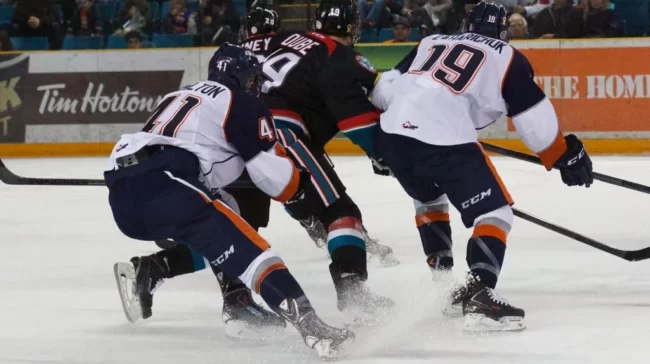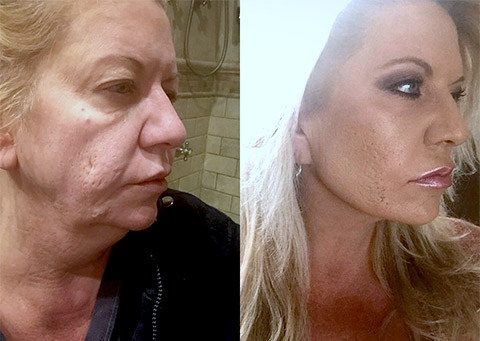
I’m a lifelong hockey player who spent over a year trying everything to fix my lace bite. I read what I could on the topic, and tried every product and lacing technique imaginable. I’m sharing what I’ve learned, presented step-by-step, so you can also skate pain free.
What is lace bite?
Lace bite is pain on the front of the foot or ankle ice hockey players may experience when skating. The medical term for this condition is tibialis anterior tendinopathy, which is essentially aggravation to the tendon that runs along the front of the foot and ankle.
When ice skating, this tendon is in contact with the tongue of the ice skate and the friction between tendon and skate can aggravate the tendon.
Lace bite usually presents with:
- A bump or swelling
- Redness
- Pain when skating or tightening ice skates
- For more severe cases, pain when touching or wearing shoes
- Located on the ankle or top of the foot
What causes lace bite?
Lace bite is caused by friction or contact between the tongue of the ice skate and the skater’s foot or ankle, which aggravates the extensor hallucis longus on the front of the foot. This is more likely to happen when:
- Skating after a long period of not skating
- Buying new ice skates and they aren’t broken in
- Skating at full speed without warming up
- Spending more time than usual in ice skates
The most effective ways to reduce or eliminate lace bite pain
Most of these strategies are fast and easy to implement, and some are completely free! I recommend you mix and match options to see what works best on your body, as everyone is a little different.
I will break down these solutions by:
- Changes you can make to how you tie your skates
- Gel pads to wear while skating
- How to reduce swelling after skating
Change how you tie your skates before playing hockey
Remember, lace bite is caused by the friction between skate and foot or ankle. The goal is to tie your skates so that the friction is reduced, while your skates remain tight and don’t impact your skating ability.
One solution is to tie your laces outside-in instead of inside-out. By tying your laces this way, the laces squeeze the entire skate boot when tightened instead of pressing directly down on the skate tongue. It keeps your skates tight without putting as much pressure directly on the tendon on the front of your foot.
Another option is to move the location of the knot at the top of your ice skates. It was noticed that the most pressure between skate and ankle was directly underneath the knot.
Moving the knot makes sense because the knot is the point that holds the lace tight. Moving the knot all the way to the left of the skate tongue before skating. Then, move the knot all the way to the right of the skate tongue. It was noted that moving the knot location between periods was optimal.
By moving the knot, you’re trying to accomplish two goals. One, don’t let the knot sit directly above your tendon, which usually aligns with the middle of the skate tongue. Two, don’t let the knot stay on any one part of your ankle for too long. The longer the knot sits in one area, the worse the aggravation becomes.
If you have lace bite on your foot or the bottom of your ankle, you can also try skipping eyelets when lacing your skates.
This lacing technique relieves pressure directly above the painful area but maintains the tightness from the lace everywhere else. Keep in mind this option will not help your lace bite if the aggravated area is above the top eyelet of your skate. If that’s the case, try the other options.
Gel pads to wear while playing hockey
Another option to reduce friction between skate and tendon is to wear a gel pad while skating. There are a couple of gel pad options to consider depending on the nature of your lace bite.
The first option is a gel pad that covers a rectangular section of your foot and ankle. The idea is to create a cushion between skate and body to reduce pressure on your tendon. Put the gel pad sleeve on before you put on the rest of your equipment. Make sure it covers the aggravated area and doesn’t have any wrinkles before slipping on your skate. When worn correctly, a skater should not even notice it’s on while skating.
The second option is a gel pad that covers an oval section of your foot and ankle. In this case, the idea is to position the gel pad sleeve so that the painful area is in the middle of the oval. The gel pad creates pressure on the oval and removes pressure from the interior of the oval. In other words, there should be little to no pressure on the area directly above your lace bite. Again, when worn correctly, a skater should not notice that it’s on while skating.
Which gel pad option should you pick? If you can position the gel pad sleeve so that the entire aggravated area is inside the oval, it’s recommended to start with that option. It should reduce more pressure from the area where your tendon is aggravated. This assumes your lace bite is on your ankle, not your upper foot, and the swelling is small enough to fit entirely inside the oval. If that’s not the case, it’s recommended to start with the rectangular option.
Wearing both at the same time with the oval on top of the rectangle can also work well. This decision is going to be dependent on your body type, and it may be worth giving all of the options a try. It’s also possible that as your swelling is reduced, you may want to switch from the rectangular option to the oval option.
How to reduce swelling after skating
Ice your foot or ankle after skating with lace bite. The goal is to reduce swelling from lace bite so that any aggravation to the tendon is minimized. Icing was a game changer for me, and I recommend this to my teammates with lace bite. Once I started icing, I noticed the bump on my tendon stop increasing in size, and then, it started to decrease.
As soon as possible after you skate, ice for 15-20 minutes. I prefer to ice in the locker room while taking off equipment and talking to teammates. I bring an ice pack to the rink in a small cooler that I toss in my hockey bag. Then, I keep a second ice pack in my freezer at home and ice again after driving back.
Ice consistently after every time you skate. Every time! Also, use an ice pack that ices the entire area surrounding your lace bite. Some ice packs are shaped better to cover the entire foot and ankle area than others.
In addition to icing, topical pain relieving gel can help with recovery between skates. These gels are commonly used for conditions like arthritis.
Lace bite can be caused by skating full out right away. Warm up before every game to ease your skate and tendon back into skating.
Putting it all together
Lace bite affects everyone’s body a little differently. What works for me might not work for you. I recommend trying a variety of options in combination until you find success.
Also Read: The reasons why some Blade and Soul players quited the game




